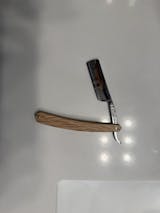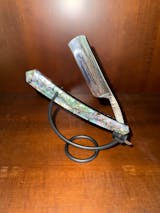The Beginner's Guide to Shaving With A Double Edge Safety Razor
Are you wondering how to use a safety razor? The first few times we used a safety razor was purely experimental and it resulted in a few bathroom bloodbath scenes before we got it just right. Well, bloodbath is the wrong way to descibe it, let's just say we cut ourselves a few times shaving with a safety razor. We don't want that to happen to you so we created this beginner's guide to double edge safety razors.
Shaving with a safety razor is an incredible feeling. Whether you're making a change from disposable razors or electric razors, or you're new to wet shaving altogether, this article will help you get started shaving with a safety razor in a number of ways:
- Learn to choose your first safety razor
- Know the basics of how to use a safety razor
- Learn how to store your safety razor
- Learn safety razor tips
The fine edge of just one good blade flawlessly slices each follicle at just the right point, leaving your chin and cheeks smooth and in a smiling position. It is so immensely satisfying you might end up building a routine around it. Generations of men have, we have, and a new crop of men are too.
Why so? Because shaving isn't just grooming, it's how you spend your time. And with a safety razor, it's a pause from the everyday.
What Is a Double Edge Safety Razor?
One of the things that confused us when we just started was how people used the words "safety razor" and "double-edge razor" interchangeably.
Double edge razor blades (also called DE safety razors) and safety razors are the same things! A handheld, wet shaving device where the razor blades—referred to as double edge razor blades—are exposed on both sides, hence the name—double edge razors (see below). As a side note, you'll need to get a good stock of blades at home to use your Safety Razor.

Safety Razor Quick History
We talk about double edge razors today because a long time ago, dating back to the 1700s, there used to be single blade safety razors. These single blades were solid and sharp, but in the early 20th century, even more, robust double edge blades took over the market.
It wasn't until 1974 when Bic introduced the disposable razor, that single blades crept back onto men's bathrooms. Have any guesses as to who invented double edge razors?
King Camp Gillette, founder of Gillette (not an actual King) of disposable razor fame (Turns out there's more money to be made in disposables, which is fine with us because we're here for the love of the craft).
For a time, safety razors were forgotten, but in the past few years, men and women have rediscovered this magnificent shaving tool. But enough lore, talk about how using a safety razor can make your life a little better.
How To Choose What Traditional Safety Razor Is Right For You
9 Questions to ask yourself before switching to a safety razor
- Is it because they're more gentle on sensitive skin and you've got a tendency towards razor burn?
- Are you tired of getting ingrown hairs each and every time you shave?
- Do you want a closer shave?
- Do you want your shave to cost less?
- Do you want there to be less plastic in the world?
- Do you want to make the most detailed shapes and lines with your facial hair?
- Do you like the way a razor feels significant in your hands and smart in your medicine cabinet?
- Are you just looking to relax and do something good for your mind and body?
- Do you care bout the environment and your carbon footprint?
There are no wrong answers (except number five). We're here for all of it. So welcome to the world of safety razors, and congratulations on your desire to make a positive change in your life! Now, let's dive right into the information standing in the way of getting you started.
The Different Features of Safety Razors Explained
When buying your first few safety razors, it's best to start with understanding the different options of safety razors available.
We've broken down our explanation of the safety razor by the parts that matter when shopping. In each description, we've got tips for beginners on how to make decisions.
Which is the best Safety Razor: One? Two? or Three-Piece?
No, not fried chicken (though you deserve some after reading this!). Shaving!
A disposable razor only has one piece (maybe two): the handle and the cartridge razor. Safety razors are different and can have multiple pieces: 1, 2, or 3.

They consist of a body and a razor head that can come in one, two, or three separate pieces. And then you add the razor blade separately. So that's a possible four piece selection for your safety razor menu item. It's hard for novices to go wrong here. The differences among the different head designs are slight, but they can make a difference in your comfort level.
Beginner's Tip: Unlike disposable cartridge razors, which are one-sided, both sides of a double edge razor head can be used (hence the name). You can alternate sides of each stoke for different uses, like shaping vs. shaving, or on distinct parts of your face. How cool is that?
One-Piece Safety Razor: The Butterfly
The one-piece safety razor is one solid instrument from top to bottom. The razor head is opened like a tesla X and the double-edge blade is placed inside, secured, and then closed back up. It's often referred to as a "butterfly safety razor" because it resembles a butterfly's wings when the head opens.
- Pros: Never lose parts
- Pros: Easy to clean
- Pros: Fast to change blade
- Cons: Movable parts can break after prolonged use

⚡ Beginner's Tip: A one-piece double edge razor makes an excellent first option; inserting the blade is a cinch. One-piece safety razor design is hard to find these days.
Two-Piece Safety Razor
Two-piece safety razors are a surprise—two pieces. The body and the top separate and the razor head comes off, allowing you to place a razor blade on the bottom of the head. Close it up and your two-piece is ready to rock and roll.
- Pros: Easy to insert blade
- Pros: Keeps good blade alignment
- Pros: Durable
- Cons: Shaving gunk may build up if not cleaned regularly

⚡ Beginner's Tip: Two-pieces are an excellent option for beginners because it's easy to keep the blade aligned. Edwin Jagger makes some nice two-piece safety razors.
Three-Piece Safety Razor
A three-piece is like a two-piece except the bottom portion of the razor head also comes off the body. The base of the head gets unscrewed from the body, then the head is separated, a blade inserted, aligned, and then closed back up and refastened to the body.
- Pros: Easiest To clean
- Pros: Holds blade securely in place
- Pros: Durable
- Cons: More pieces to lose, increased razor blade handling time
⚡ Beginner's Tip: Three pieces can be a little tricky because you have to align the razor blade, but try it out because you'll want to learn sometime! Just make you have a steady hand. The Henson collection is a great three-piece Safety Razor and one of our best sellers.
Open Comb vs. Closed Comb Safety Razors
The comb factor of a safety razor has to do with its aggressiveness.
The word aggressiveness describes the ease at which the razor moves over your face and how close it cuts the hair when it comes to razors. The less easy it is to swipe your blade over your stubble, the more aggressive the edge. But you can also call a blade that cuts close (in a smooth way) aggressive too.
The vast majority of people shave with a closed comb head razor which is the less aggressive option. The closed comb has a safety bar beneath the blade that provides some protection between the razor blade and your neck and helps reduce nicks, cuts, and razor burn.
Open comb blades are on the more aggressive side. They are made with the teeth of a comb beneath the blade's edge, which helps direct the hair and allows plenty of shaving cream to get inside. Guys with coarse or thick hair worthy of a machete sometimes prefer an open comb.
Beginner's Tip: Start with closed-comb razors so you can shave with safety, and work your way up to an open comb head if need be.
Fixed or Adjustable Razors?
When picking between a fixed or adjustable razor head, it becomes a question of how much do you want the razor blade exposed when you shave. On a fixed blade, blade exposure is factory set, usually to milder shave strength, and never changes. On an adjustable, you can change the blade exposure settings according to your preferences.
You can think about razor heads like interest rates. Fixed is better for most but there are certain times when an adjustable rate does just the trick. Most razors are fixed but a new breed of more user-friendly adjustable blades has been earning fans.
Beginner's tip: Start with a fixed blade because it will allow you to focus on your wet shaving technique. An adjustable comes in handy when you know more about just the settings you like rather than discovery.
Razor Handle Length
Most double edge safety razors are between 3 and 4 inches and the difference is a matter of personal preference. If you have big hands, chances are you'll feel more at home with a longer handle, but there are plenty of big-palmed men using 3-inch razors. It's all about what is comfortable for you.
Beginner's Tip: Try handling a few forks and knives. If you tend to like bigger, bulkier silverware, you might feel more comfortable with a longer blade.
Handle Material and Texture
Handles have to serve two functions: feel snug in your hand and look good on the shelf. Because they live in the bathroom, they also have to withstand corrosion due to moisture. Any material you select will accomplish both, so there's a fair amount of personal taste involved in making your selection.
Here are a few of the best materials no matter your level:
- Brushed Stainless Steel: has a matte, lightly textured polish
- Chrome Finish: a layer of corrosion-resistant chrome is laid over another material like brass.
- High-Grade Ivory Resin: a resilient and durable synthetic material with looks to match
- Stainless Steel: a metallic alloy that resists corrosion
- Anodized Aluminum & Graphite: treated metals that are impervious to corrosion
It's easy to want the most beautiful razor first, but think about how it will feel in your hands. Naked Armor makes some nice wood handle options at affordable prices.
Beginner's Tip: Textured handles will be easier to control than those with smoother surfaces.
Weight
The razor's weight means more than how much it weighs; with a safety razor, it's the actual force behind the act of shaving. Unlike disposables, where you apply pressure, when you use a safety razor, little to no force should be used. The weight of the instrument should lead the way.
So, if you choose a light double edge razor, you could end up using too much pressure, leading to bruises. If you go with a heavy safety razor, it could instigate an overly aggressive shave under your nose. Most safety razors are between 2 and 4 ounces, so the variance is slight. Weight distribution also comes to play. Still, as you learn more about your shaving preferences, you may favor one variation over the other.
Beginner's Tip: Even if you hold one in your hands in the store, it's not till you're a few shaves in that you'll start to get the hang of it. We say, if you see something you love and it's possibly too light or heavy, it's okay to try it out; you might find something you really love. Start with a Safety Razor kit.
Using Your Safety Razor: Techniques for Novices

Selecting your sword is only half the battle; now, you have to use it correctly. The good news is that even though it is a slightly different technique than with a disposable cartridge razor, DE shaving with a safety razor is just as easy to master.
You'll eventually find a technique of your own that suits your particular curves and angles, but before you can bend the rules and start shaving, you've got to learn them. So here are the main steps in wet shaving with a double edge razor.
1. Pre-Shave Preparation
Like with a disposable cartridge razor, you need to hydrate your hair and skin before dragging a razor blade across it. This step softens your stubble and seriously reduces the risk of skin irritation, razor burn, especially if you have sensitive skin and looking for a close and comfortable shave.
You can prep in one step, but the optional second step can help guys with problematic skin:
- Wet your face. A shower gets the job done, but if you want to take things to the next level, grab a soft, wet hot towel and leave it on your face for a few minutes of bliss.
- Pre-shave lubricant. You can use a pre-shave oil, lotion, or gel to help pave the way for the razor blade, especially helpful for inflamed skin.
2. Lathering 101
Applying lather with shaving creams or shaving soaps to your face makes your hair stand up so the razor can chop it down and get that great shave. And it's easy and fun to do.
You can use a shaving cream or a soap, but there are a few different ways to lather up, ordered here from best (1) to worst (3):
- Use a shaving brush and a bowl (or puck of shaving soap). This method cleans you up the most, giving you the creamiest lather, the most lift, and bonus exfoliation (shaving brushes remove dead skin cells that can cause ingrown hair). Want a hot shave? Try a shaving scuttle.
- Directly to your face with a shaving brush. This method works, but your lather may not be as effective as it could be.
- Directly to your face with your hands. Will you be able to shave? Likely. Will it hurt? Unless you've got the hair of a newborn, probably.
Lathering in a bowl or puck of shaving soap can be done in 3 simple steps. First, pre-soak your brush so that it's saturated but not dripping wet. Then, grab a dime-sized gob of shaving cream and drop it into a bowl (or open the canister if you have a puck) and a few drops of water. Finally, swirl it around in the cream for 30-60 seconds (about 50 revolutions) until you have a nice, buttery thick lather. You can add water and cream to adjust the consistency. When you're done, clean and dry your brush properly to keep its quality.
Beginner's Tip: Try the bowl and lather method compared to bare-handing it. You'll notice a big difference. Remember to map your face with the lather to easily learn if you'll shave with or against the grain.
3. Safety Razor Shaving Stroke Technique
The central concept behind the safety razor technique is to shave with the grain first and let gravity do the work. Less drag equals less irritation and lets the razor glide but still offers a close shave.
Here's a quick cheat sheet on proper safety razor shaving techniques:
- Hold the razor at about a 45-degree angle to your face and use short gentle strokes and as little pressure as possible in the first pass this will give you a much milder shave
- Place the blade at the top of the area you are shaving, going with the grain
- Allow it to glide down without applying pressure in the same direction
- Lift and turn the double edge razor over and overlap areas with remaining hair growth using the other side of the razor blade.
- Repeat going across the grain.
- Optional: repeat going against the grain
Once you feel comfortable with the razor, you'll be able to tailor a more personalized technique.
4. Post-Shave Care
You've done the hard part, and now comes the clean-up. Splash some cold water on your face to wash away any lingering lather and close up your pores.
Finally, you want to clean your skin, so you don't get ingrown hairs or infections. Dab on an aftershave splash, lotion, gel, or tonic, which have astringents made to disinfect your skin. Then, seal the deal with a moisturizer to give your skin the nutrients it needs to stay healthy.
Caring for Your Safety Razor
If you don't clean and care for your double edge razor the blade will dull more quickly and the pieces will rust, making it hard to use. Maintaining a sharp blade and a properly functioning double edge razor takes a few simple steps at the end of your ritual:
- Clean the blade- Rinse with warm water.
- Dry the blade- Pat it down with a towel.
- Disinfect- Dab the blade edge with rubbing alcohol.
- Apply oil to the head- Cover the blade in baby oil or mineral oil to prevent rust.
- Replace The De Blade- Replacing your razor blade once per week or two will keep your shaving routine smooth and comfortable.
Even though wet shaving involves plenty of H20, too much water corrodes the pieces of the razor, so be sure to store it in your medicine cabinet or a drawer. Avoid leaving it out in the open.
The Best Safety Razors for Beginners
We're nearing the end but we wouldn't send you off into shave land without a little more concrete direction, so here is a few Grown Man Shave safety razor suggestions for beginners. First I'll list the top three choices and our best sellers and then we'll add a few more options to expand your selection.
Grown Man Shave Top 3 Best Sellers Safety Razors
- Henson A13 Medium (review)
- Edwin Jagger DE89 Double Edge Safety Razor Extra Grip (DE89 review)
- Rex Envoy Stainless Steel Double Edge Safety Razor
Best Priced Safety Razor
- Merkur 20C Classic Double Edge Safety Razor
Grown Man Shave Top 7 Safety Razor Contenders
- Muhle Rocca Pure Matt Stainless Steel Safety Razor
- Merkur Futur Adjustable Safety Razor (review)
- Taylor of Old Bond Street Victorian Black Safety Razor
- Edwin Jagger 3ONE6 Stainless Steel Knurled Handle DESSKNBL Safety razor
- Merkur 34c HD Double Edge Safety Razor (review)
- Muhle R41 Open Combed Safety Razor (review)
- Merkur 34c Heavy Duty Double Edge Safety Razor
Henson Aluminum A13 Medium Safety Razor
The Henson Shaving AL13 medium safety razor is made from aerospace-grade aluminum provides a wider blade gap than the Al13 mild razor for those who desire slightly more aggressive blade or who prefer to wet shave with a medium blade gap exposure and medium aggression perfect with those with coarser hair.
- Safety Bar: Closed Comb
- Aggressiveness: Medium
- Compatible with any standard DE blade
- Retail Price: $75.00

- - - GMS - - -
Edwin Jagger DE89 Double Edge Safety Razor Extra Grip
The exceptional performance and finish of the Edwin Jagger 3ONE6 Stainless Steel Double Edge Safety Razors has been achieved using innovative product design and advanced precision manufacturing techniques.
- 3 piece safety razor style
- Knurled handle
- 316 Stainless Steel Head
- Retail Price: $136.00

- - - GMS - - -
Rex Envoy Stainless Steel Double Edge Safety Razor
The precisely machined cap, guard and handle disassemble smoothly to accommodate the shaver’s choice of most standard double-edge blades. Reassembled, the blade rests at a medium setting, the equivalent of a “3” on the company’s adjustable “Ambassador” model.
- 3 Piece Style
- Length: 3.5" 87mm
- Weight: 3.73oz 106g
- Blade Gap: 0.025"
- Retail Price $150

- - - GMS - - -
Merkur Black Resin Handle Double Edge Safety Razor
The Merkur 20C Classic Double Edge Safety Razor with extra-long Matte Black handle contrasted with bright chrome head and accents accentuate the 20c's elegant diagonally ridged handle. This safety razor impresses with a sophisticated presentation.
- 3-piece razor design
- Suitable for sensitive skin
- Safety Bar: Closed Comb
- Aggressiveness: Medium
- Retail Price: $61.00
Others Safety Razors to Consider:
MERKUR 34C HEAVY DUTY DOUBLE EDGE SAFETY RAZOR
EDWIN JAGGER DE89 DOUBLE EDGE SAFETY RAZOR EXTRA GRIP
EDWIN JAGGER 3ONE6 STAINLESS STEEL KNURLED HANDLE DESSKNBL SAFETY RAZOR
MUHLE ROCCA PURE MATT STAINLESS STEEL SAFETY RAZOR
MERKUR BLACK RESIN HANDLE DOUBLE EDGE SAFETY RAZOR
TAYLOR OF OLD BOND STREET VICTORIAN BLACK SAFETY RAZOR
MÜHLE R41GS GRANDE SAFETY RAZOR STAINLESS STEEL
Frequently Asked Questions: Safety Razors
1. How often do I change the blade?
Most shavers will use a new blade once and twice a week. But there are a few tips and tricks to extend the life of your blade.
2. How do I pick a double edge razor blade?
Start with small packs from a variety of manufacturers until you find the one you love. We have all the main brands available.
3. Where can I store my safety razor?
Store your safety razor using a stand or an inside a case. You need to keep your safety razor dry and clean.
4. How do I stop the bleeding!?
About that. Bleeding might happen when you start out. But, you're new to this, so it's okay; even the pros do it sometimes. Use an aftershave, but if that doesn't work, try an alum block and for deep cuts, reach for a styptic pencil. Then tweak your shaving style and if that doesn't work you might want to try a different razor blade.
Here's To New Beginning's and Happy Lathering!

















